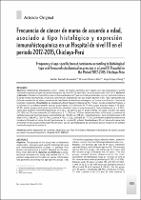Frecuencia de cáncer de mama de acuerdo a edad, asociado a tipo histológico y expresión inmunohistoquímica en un Hospital de nivel III en el periodo 2012-2015, Chiclayo-Perú
Related Resource(s)
http://cmhnaaa.org.pe/ojs/index.php/rcmhnaaa/article/view/129Date
2019-02-16Author(s)
Galindo-Céspedes, Andrés
Velasco-Vela, Orlando
Fupuy-Chung, Jorge
Metadata
Show full item recordAlternate title
Frequency of age-specific breast carcinoma according to histological type and Immunohistochemical expression in a Level III Hospital in the Period 2012-2015, Chiclayo-Peru
Abstract
Objetivo: Determinar asociaciones entre cáncer de mama específico por edades con tipo histológico y perfil inmunohistoquímico en pacientes de un hospital de nivel III Chiclayo-Perú, durante el periodo 2012-2015. Material y Métodos: Estudio retrospectivo transversal realizado en 271 pacientes diagnosticadas con carcinoma de mama a lo largo 4 años consecutivos. Se obtuvo información, trabajando con dos grupos etáreos (<55; >55) y aplicando una ficha de recolección de datos, partiendo de resultados de Anatomía patológica, en la cual se utilizaron criterios de inclusión/exclusión. Resultados: La edad promedio de las pacientes fue de 56,19 años, siendo la máxima 95 años, y la mínima 28. La edad promedio para el grupo menor a 55 años fue 44,77 años y para el grupo mayor a 55 años: 67,07; Ambos grupos mostraron características similares para su asociación para tipos histológicos (p = 0,353), como para perfiles Inmunohistoquímicos (p=0.757). Se obtuvo que el grupo etáreo <55 años, incluyo 123 casos (93,18%) con CDI (carcinoma ductal infiltrante), 3 (2,27%) con CLI (Carcinoma Lobulillar infiltrante), y tuvieron al subtipo molecular Luminal A como Luminal B con 63 (50,4%) y 23 (18,4%) respectivamente, para el grupo mayor a 55 años: CDI 123 (88,49%), CLI 8 (5,76%), Luminal A 73 (53,3%) y Luminal B 24 (17,5%). La frecuencia general mostró una tendencia bimodal así como los subtipos Luminal A, Luminal B, y Basal. Conclusiones: El carcinoma de mama más frecuente se dio en pacientes mayores a 55 años, con el tipo histológico de Carcinoma ductal Invasivo y el subtipo inmunohistoquímico Luminal A. Objetive. The purpose of this study was to determine
relationship between aged-specific histological types
and immunohistochemical profiles in patients with
breast carcinoma from a level III Hospital in Chiclayo-
Peru, from 2012-2015. Material and Methods: A crosssectional
retrospective study was carried out in 271
patients diagnosed with breast carcinoma. Information
was gathered, according two age-specific groups (<55;
>55) and by applying a data collection sheet, based on
clinical records from the Pathological Anatomy Service.
Results: The average age was 56.19 years, maximum
age was 95 years and minimum age was 28. The average
age for the first group (<55 years) was 44.7 years and
the second group (>55years) was 67 years. The two
groups showed similar characteristics for their
association of histological types (p = 0,353), as well as
for immunohistochemical profiles (p=0.757; p =0.576).
Patients under 55 years included 123 with IDC (93.18%),
3 with ILC (2.27%), 63 with molecular subtype Luminal A
(50.4%) and 23 with Luminal B (18.4%). For the group
over 55 years: 123 with IDC (88.49%), 8 with ILC (5.76%),
73 with Luminal A (53.3%) and 24 with Luminal B (17.5%). The overall frequency showed a bimodal trend
as well as the molecular subtypes: Luminal A, Luminal
B, and Basal-like. Conclusions: Older patients
presented a higher frequency of breast carcinoma than
young patients, with CDI tumor type and Luminal A
molecular subtype.






